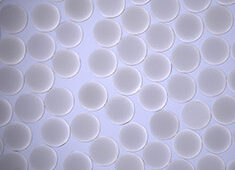The tiny cycloidal vortices composed of only approximately 15 atoms form a regular, almost square lattice. In the right section of the illustration the magnetic measurement by spin-polarized scanning tunnelling microscopy is shown as a gray-scale image. The square cutout represents a single skyrmion. The colored cones show the magnetic direction of the individual, hexagonally arranged iron atoms of the metal film. Picture credits: M. Menzel, University of Hamburg |
Physicists
at Hamburg and Kiel University and the Forschungszentrum Jülich have
found for the first time a regular lattice of magnetic
skyrmions?cycloidal vortex spin structures of exceptional stability?on a
surface. This fascinating magnetic structure was discovered
experimentally at the University of Hamburg by spin-polarized scanning
tunnelling microscopy and imaged on the atomic scale. Theoreticians at
the Christian-Albrechts-Universität zu Kiel and the Forschungszentrum
Jülich were able to explain this magnetic state with the help of quantum
mechanical calculations performed on supercomputers. As the scientific
magazine Nature Physics reports online on July 31, 2011, the researchers
discovered the magnetic skyrmions, which consist of 15 atoms, in an
atomic layer of iron on the surface of an iridium crystal. This
discovery could give new impetus to the area of spintronics.
About
50 years ago the theoretical physicist, Tony Skyrme, studied quantum
mechanical field theories and to his surprise found stable and localized
configurations that interact with each other and can arrange themselves
in a lattice in the same way as atoms. Due to these properties he
identified these vortex-like solutions as elementary particles. These
skyrmions named after their discoverer later appeared in many different
fields of physics and developed into an important concept. The possible
formation of skyrmions in magnetic materials had already been predicted
20 years ago and was also confirmed experimentally in bulk materials.
The
magnetic skyrmion lattice discovered in Hamburg occurs in an atomically
thin film on a surface. The diameter of the vortices is only a few
atoms and is thus at least one order of magnitude smaller than the
previously known magnetic skyrmions. As it is often the case chance also
played a major role in this discovery.
“It
is known that iron can sometimes form unusual magnetic structures.
Still it was a great surprise when we found this almost square magnetic
structure on the nanometer scale which is not really compatible with the
hexagonal system of the iron atoms,” says Dr. Kirsten von Bergmann,
member of the experimental research group headed by Prof. Roland
Wiesendanger in Hamburg.
The
fact “that a sophisticated variation of the experimental setup gives
data that can be compiled to yield the complicated magnetic structure” also
fascinates Matthias Menzel, a postgraduate student.
In
order to understand this intriguing spin structure and the exceptional
symmetry breaking between magnetic and atomic order, the theoreticians
at the University of Kiel and the Forschungszentrum Jülich had to
develop a model for the spin structure and carry out complex quantum
mechanical calculations on supercomputers at Jülich. These provided the
confirmation that stable magnetic skyrmions form on this metal surface.
Professor
Stefan Heinze, head of the research group in Kiel: “With the help of
our model we were able to specify the precise spin structure in the iron
film and identify it as a skyrmion lattice. The comparison with the
experimental data provided the ultimate proof for our discovery.”
The
interplay of various magnetic interactions is the cause for the
occurrence of this complex structure. While the canting of atomic spins
with a certain rotational sense is caused by the antisymmetric
Dzyaloshinskii-Moriya interaction, the skyrmions found here can only be
induced by the so-called four-spin interaction with the participation of
four magnetic atoms.
The
magnetic skyrmions found open up completely new possibilities for
future applications, for example in the field of spintronics, but at the
same time raise new questions: How does electric current interact with
the skyrmions and can we deliberately move the magnetic vortices in a
specific manner?
Spontaneous atomic-scale magnetic skyrmion lattice in two dimensions





